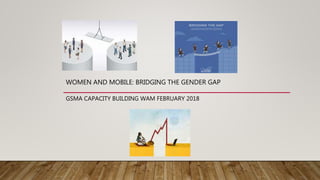
Wam latest
- 1. WOMEN AND MOBILE: BRIDGING THE GENDER GAP GSMA CAPACITY BUILDING WAM FEBRUARY 2018
- 2. BRIDGING THE DIGITAL GENDER GAP • To bridge this digital gender gap, we need greater investment across the board. • We need to build digital literacy skills into education systems, to overcome inequalities in access, and to integrate gender perspectives into all strategies and plans. • To collect sharper data in order to design targeted policies for relevant services, applications and content. • Worldwide, there is a gender gap of 12 percent in male and female access to the Internet. • This rises to almost 3 percent in Least Developed Countries
- 3. FACTORS IN THE DIGITAL GENDER DIVIDE • There is an urban-rural divide related to the gender gap in Internet use. In rural areas, the gender gap is higher in high-income countries (9.4%, compared to 7.5% in low- and middle-income countries). This trend is somewhat reversed in urban areas, where the gap is slightly higher (at 6.6%) in low- and middle-income countries, than in high- income countries (6.3%). While this data on urban-rural Internet use is only available for 16 out of the 69 countries covered in the ITU’s dataset, these findings on the urban gap are consistent with other research. For example, the Web Foundation’s Women’s Rights Online research surveyed urban poor communities in ten low- and middle- income countries and found that women were nearly 50% less likely to access the Internet than men in the same communities. • Age is also a factor in the digital gender gap. The digital gender gap increases as age increases, and is more significant in low- and middle-income countries. Among 15-24 year old's, the gender gap is 2.9% in low- and middle-income countries. However, there is a negative gap for this age group in high-income countries, where Internet use among women is slightly higher (by 0.5%) than men. The gender gap in Internet use grows among the 25-74 age group across all countries, but is higher again for low- and middle-income countries (7.7%) compared to high-income countries (3.5%). When we look at the age group 75 and above, the gender gap becomes significantly larger, with an average gap of 45.8% across all countries. Again, these findings are supported by the Women’s Rights Online research which also shows the gender gap increasing with age in urban poor communities.
- 4. BARRIERS PREVENTING WOMEN FROM USING AND OWNING MOBILE PHONE • Cost • Network quality and coverage • Safety and harassment • Operator/agent trust • Technical literacy and confidence
- 5. MEASURES TO ADDRESS THE BARRIERS FACED BY WOMEN • Affordable access: improved understanding of affordability issues; innovating to reduce the cost of devices and services; improving network coverage, capacity and quality; and providing public access facilities • Addressing threats that prevent access and use: researching and understanding threats; increasing awareness of threats and how they can be addressed or reduced; developing safety applications and services; and strengthening protection measures and reporting procedures. • Relevant content, apps and services: building awareness; developing relevant content and services; and consulting and engaging women.
- 6. WHO IS ADDRESSING THE GENDER DIGITAL DIVIDE? • ITU • UN Women • GSMA • WEF • UNESCO
- 7. HUMAN RIGHTS IMPLICATIONS OF THE GENDER DIGITAL DIVIDE FOR WOMEN AND GIRLS • Censorship, the internet has become a critical space for women to access relevant information, which is often unavailable to them offline due to social and cultural norms –for example, information on sexual health and reproductive rights. • Violence against women online, Acts of gender-based violence that are committed, abetted or aggravated, in part or fully, by the use of ICTs such as phones, the internet, social media platforms and email are violations of women’s fundamental human rights. They also act as a significant barrier to women’s use of the internet
- 8. ACTION PLANS TO ADDRESS DIGITAL GENDER DIVIDE • Education- there is a great need to ensure that girls are enrolled into secondary school to further their education. Most of the drop out in Africa is due to lack of provision of sanitary towels for girls. Therefore miss an opportunity to participate in school activities and access to ICT services due to illiteracy. • Employment- there is a shortage of female representation in the senior management and executive management in the ICT Sector. For instance CEOs for Mobile operator in South Africa are all male.
- 9. CONCLUSION • Women are less likely to complete their studies, in other words their high schools and tertiary, due to many reasons such as getting pregnant. • Access to mobile by women and girls remains the biggest challenge across the globe, especially in low income countries and rural areas. • Of particular importance is to encourage policy makers and private sector to engage in issues that will bridge the digital gender gap that is affecting women and girls and therefor hindering full participation and access to ICT services.
- 10. REFERENCES • GSMA Connected Women The Mobile Gender Gap Report 2018 retrieved from https://www.gsma.com/mobilefordevelopment/programmes/connected-women/the-mobile-gender-gap- report-2018 • Big Data and the well-being of Women and Girls, 2017 retrieved from https://www.cfr.org/blog/big-data- filling-gender-data-gaps-and-pushing-us-closer-gender-equality • UN Gender Mainstreaming: An Overview retrieved from http://www.un.org/womenwatch/osagi/pdf/e65237.pdf • https://webfoundation.org/2016/10/digging-into-data-on-the-gender-digital-divide/ • http://broadbandcommission.org/Documents/publications/WorkingGroupDigitalGenderDivide- report2017.pdf • ITU Action Plan of Plan to close the digital gender gap retrieved from https://www.itu.int/en/action/gender- equality/Documents/ActionPlan.pdf